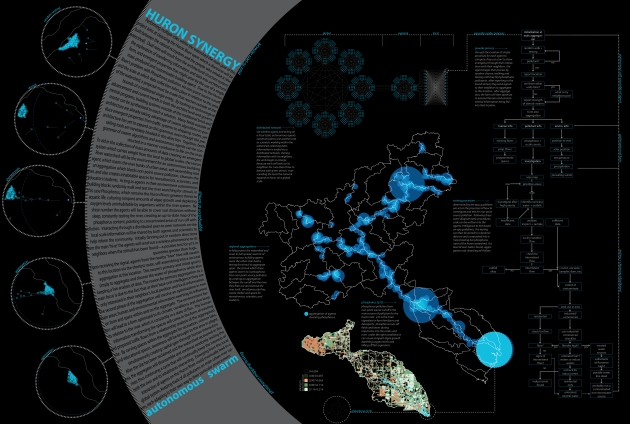Performing multiple roles within the watershed the main goal of this project aims at cleansing the Huron River, upon which a discourse will be built between the natural ecosystem and the people who inhabit it [the watershed]. Dual functions will result from the architectural structure system; an exploration of transferring information and data into architectural form, and the emergent properties that might arise by the use of a single mass-produced and customizable building agent. Due to the Huron River’s problem with Phosphorus pollution via non-point source runoff, and the scale at which data collection takes place in relation to the area of the watershed, a proposal must be made that reaches outside of the bounds of a traditional single entity. By looking at technological advancement and current trends in both the architectural and governmental programs, building systems outside of the traditional brick and mortar can be synthesized to reach a solution. Numerous fields outside of the architectural profession are already taking advantage of swarm algorithms to produce emergent properties, from traffic systems to shipping routes, yet architecture has yet to expand on this grammar and technology, even though the prevailing tools (parametric modeling) are inevitably headed in this direction. Together, both grammar of swarm algorithms and autonomous agents can be constructed in a manner conducive to life on the river.
To aid in the collection of mass amounts of data, through the creation of an emergent system which carries the flow of information from the local to global scales, the Huron River watershed will be the environment for an autonomous building agent which roams the river banks of dense urban areas, self-assembling into an aggregation which blocks non-point source pollution, cleanses the river, and also creates habitable spaces for recreationists, scientists, and educators/students. Acting as agents in their environment, autonomous building blocks randomly walk and test the river searching for stimuli, in this case Phosphorus, which remains the Huron Rivers greatest threat to aquatic life, culturing rampant amounts of algae growth and depleting oxygen levels uninhabitable by organisms within the river ecosystem. By shear number the agents will be able to cover vast distances, constantly testing the river, creating an up-to-date map of the phosphorus content, pointing to concentrated areas of run-off pollution. Interacting through a distributed peer-to-peer network on the local scale information will be shared by both agents and scientists to help inform the community.
Initially fanning out in random directions from the main “hive” agents will send out a wireless pheromone to its neighbors when the stimuli has been found—a positive test for p15 in quantities greater than 5ugL. Upon receiving the signal, agents from the nearby hive will swarm to this location via the shortest route, self-assembling into a second aggregation at this location. The swarm’s primary and initial goal is simply to aggregate and cleanse the water of phosphorus while also keeping a live analysis of data. The reason for primary aggregation as a main focus for the agents is due to the fact that at their base unit of intelligence they are only interested in their neighbor’s local position and local information. The second phase of the aggregation will involve an optimization in two main areas; human and environmental information exerting influence on form and space within and on the aggregate. The environment factors will lead to a form optimized to its climatic conditions and also keep its relation to the river, which is constantly in a state of flux. The human information transforming the spaces will come in the form of existing and proposed human traffic flows from a relationship analysis of the aggregated site. By carving voids within the aggregate for recreation, science labs, and educational spaces, awareness will be brought to the area in plight, simultaneously creating capital gain through human interaction.
After the site has been reclaimed, and the watershed recovered in this area, the aggregates will disassemble and continue randomly testing the river and repeating the entire process, thus continuing a cycle that will continually keep the interests of both the river and its inhabitants interacting. Emerging from this local interaction of agents on the Huron River could eventually lead to a global system, keeping track of all pollutants on main urban river systems, each adapting in their own way to their particular environment.
huron synergy::autonomous swarm
Categories: Architecture, Biomimetics, Theory
Subscribe
Connect with archimorph and help grow the network.







hola. soy autónomo desde el año2000 , anteriormente he cotizado por cuenta ajena, en total poseo cotizados 33 años y voy a cumplir en abril 60 años.
hoy en día trabajo de repartidor pero lo que cobro no me da para cubrir los gastos
que cuento con a gas-oil, autónomos, etcétera si me doy de baja ¿ que posibilidades
tendría ? y en que situación quedaría de cara a la jubilación, debo de separarme para poder cobrar los 426 euros
? por el hecho de que la situación es insostenible perdiendo todos
los meses pero de 200 euros..